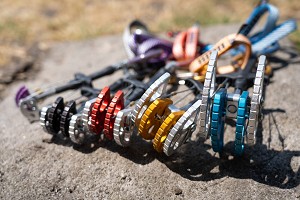
DMM Dragonflys require little introduction... but here goes. The micro cam market has been poorly serviced in recent years with some excellent contributions, but little supply. A notable absence in this market has always been DMM - arguably the UK climber's favourite cam manufacturer - and so the advent of the Dragonfly was big news. Do Dragonfly Cams live up to their excellent bigger sibling, the Dragons? I've tested them on a variety of rock types and routes throughout the UK this summer and autumn, to give my verdict.

A couple of things I'd like to set out before I begin this review. Firstly, when a comparison is relevant, I am going to compare the Dragonflys to DMM Dragons as these are from the same manufacturer and therefore the crossover in sizes is relevant (however most regular cams are similar sizes so there is lots of cross-over there too). Secondly, the opinion I give in this review is based largely on my personal experience of using the Dragonflys and other cams rather than any scientific knowledge of physics or manufacturing (which I lack!).
Sizes
The first thing you might look for in a set of micro cams is the size range: Do they go small enough for them to compliment my regular cams? How much smaller do they go than my smallest regular cam? Do they have sizes which overlap my regular cams?
The Dragonfly comes in six sizes:
- 1 Green (7.8-11mm, 6kN) Aka Super Small.
- 2 Red (8.7-12.9mm, 6kN) Still pretty flippin' small.
- 3 Gold (10.2-15.2mm, 8kN) Small and an extremely useful size - your legs don't start shaking when you think about running it out above only this cam.
- 4 Blue (12.1-17.9mm, 8kN) Overlapping with the regular blue 00 Dragon (14-21mm) but slightly smaller and much narrower head width.
- 5 Silver (15.1-22.5mm, 9kN) Overlapping with silver 0 Dragon (16-25mm) but slightly smaller and much narrower head width.
- 6 Purple (19-28.3mm, 9kN) Overlapping with purple 1 Dragon (20-33mm) but slightly smaller and much narrower head width.
In terms of the available sizes this is everything I could want from a range of micro cams. As the smallest certified cam currently on the market, you don't really need a smaller cam than the no.1 Green (and if one were was available would it even feel safe?!). With the Red and Gold too you've got three options smaller than your regular set of Dragons. At the larger end, Blue, Silver Purple overlap with smaller Dragons, so with the full range of six you're really well covered.
In terms of sizing, one of the most notable features of the Dragonfly is its narrow head width*. A narrow head is great because it increases a cam's range of placement sizes - a cam with a narrow head can fit into a narrow placement, such as in a pocket, seam or thin break. In general, I've found with cams that the narrower the head width the better - you can fit them in more places and they're therefore way more valuable. I'd always choose a narrow-headed cam over one with a wider head (I imagine there are some strength/manufacturing concerns here which mean there is a limit to how narrow you can go).
Whilst you would expect a micro cam to have a narrow head, the Dragonfly sizes which overlap the regular Dragon also benefit from a narrow head width and this is a welcome addition: it means that they are not only beneficial because their sizes overlap the regular Dragons and therefore offer additional placement options, but also because they are much narrower, again differentiating the placements which the two cams fit. As such carrying the Blue, Silver and Purple Dragonflys in addition to the Blue, Silver and Purple Dragons is a serious consideration.
*The blue Dragonfly is actually smaller than the 00 Dragon (only at full contraction of the Dragon and minimum contraction of the Dragonfly do they overlap!) and the headwidth is roughly 20% smaller.
Holding Power
The Dragonflys have the same camming angle of 13.75° as Dragons, which, say DMM, provides "the optimum balance of holding power and range".
Anecdotally (the usual caveats apply!) they hold well in a variety of rock types. I haven't fallen onto a Dragonfly in isolation, but I have fallen on clusters of gear which included Dragonflys and they've held fine. They also seem solid when you place and then tug them - I think this is the industry standard test for safety; it's certainly the most that UKC would demand of its reviewers.

Jokes aside, giving a cam a good rattling around once you've placed it is often illuminating in showing how well the cam's lobes grip that particular rock type and how much the lobes move when the the cam's stem is dragged side to side (as it could be in case of rope drag). The Dragonflys score pretty highly here as their stems are extremely flexible; in fact they seem even bendier than Totem cams which don't actually have a proper stem.
In addition, they have the classic Dragon extendable slings which mean you have to carry fewer quickdraws on your rack, though they are a little bit faffy on such a small cam. The flexible stem and extendable sling are both brilliant because they prevent your cams from walking, an issue to which micro cams are particularly prone, but it can make them more difficult for your second to remove as it's sometimes hard to move the lobes using the stem.
They also seem to grip the rock fairly well thanks to their TripleGrip lobes. These haven't got the same rock-grabbing teeth as the Dragons, but DMM say that their raw aluminium surface increases friction, meaning that the cam is more likely to hold on smooth rock types. In terms of grippiness it's interesting to compare the lobes of Dragonfly and Totem Basic micro cams. The lobes of the Totems do seem to be softer, with a more malleable surface which bites in to the rock, which would lead me to choose them over the Dragonflys for crucial placements which lack friction. However, the Dragonflys use 6082 alloy within their lobes and the Totems use 6061 - the two alloys are the same hardness and so the perceptible difference in the lobes, which may or may not lead to a practical difference, can't be explained by a difference in hardness. 6082 alloy does have a slight advantage over 6061 in that it has increased corrosion resistance.
In terms of the Dragonfly's rated active strength, they range from 6kN in the smallest two sizes to 9kN in the largest two (see the bullet points above). I'm not qualified to give any proper advice on safety ratings of climbing equipment, but 6kN is at the acceptable end of the spectrum and seems very good for the very small Green cam, whilst 9kN feels comfortable and is the same as a 00 Dragon.
Practical Considerations
As with all gear reviews, and certainly with reviews of specialist climbing protection, there are two questions you can ask yourself: firstly, is the product any good and, secondly, am I actually going to use the thing? The reason I bring this up is that, when it comes to climbing gear, there are loads of fantastic protection options out there which are ideal for different situations: hexes, cams, small nuts, big nuts, tri-cams, slings, micro cams etc., but if you carried every size of each piece of gear you'd never get off the ground (although I do often try)!
Fortunately in the case of the Dragonfly I can answer yes to both questions: they're both a very good piece of kit and I will actually add (most of) them to my regular rack.
I can see the Green, Red, Gold and probably Blue Dragonflys all being a default fixture on my trad rack. They're brilliant sizes, have great features such as flexibility and extendable slings and seem strong enough that I'm confident in them.
Those things all apply to the Silver and Purple cams too and I think there's situations where I will take them, however if I was to carry them in addition to my regular silver and purple Dragons I would be carrying a lot of gear and I wouldn't choose to carry them instead of my regular Dragons. The Silver and Purple Dragonflys are extremely flexible like their smaller counterparts, which does bring benefits but means that they don't feel as robust as the equivalent sized Dragons. As such I'll keep my Silver and Purple Dragonflys in reserve for when I need to double up on a specific size of cam, and as they have a narrower headwidth and different range to the Dragons, they will compliment them nicely.
Overall
The Dragonflys are an excellent set of micro cams which cover all the placement sizes you could ask for and offer the benefits of a narrow headwidth, extremely flexible stem and extendable sling. The placement sizes also overlap nicely with the DMM Dragons, which is great if you're double-racking cams. My only criticism (and I'm digging deep here) is that the alloy on the lobes of the Dragonfly isn't quite as soft as it could be, and therefore might not bite as well. Overall, if you're looking for a set of micro cams to complete your rack then the Dragonfly is an excellent option. DMM's long-anticipated entry into the micro cam market was worth the wait!
DMM say:
Dragonfly Micro Cams provide versatile protection for narrow cracks and pockets. The size 1 Dragonfly is our smallest certified climbing cam. The six cams in the range cover placements from 7.8mm – 28.3mm.
The same camming angle of 13.75°, as used with our Dragons, provides the optimum balance of holding power and range. You will appreciate the holding power of the TripleGrip lobes with their 'raw alu' surface, particularly on smooth rock types such as slate and limestone. The narrow head width and compact trigger allow the cams to be placed deep in small pockets.
For more info see dmmclimbing.com




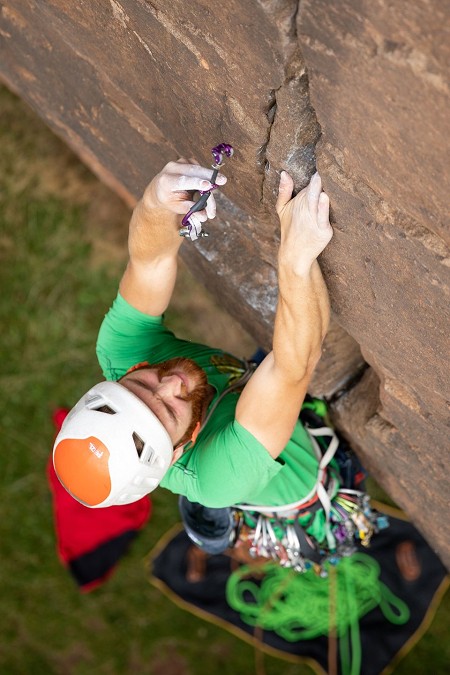
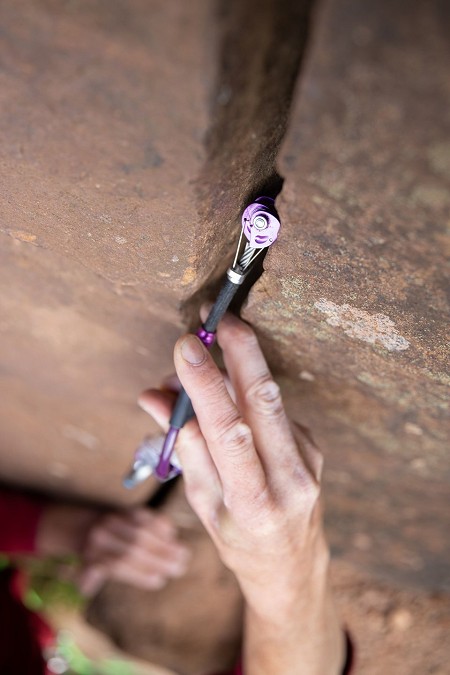



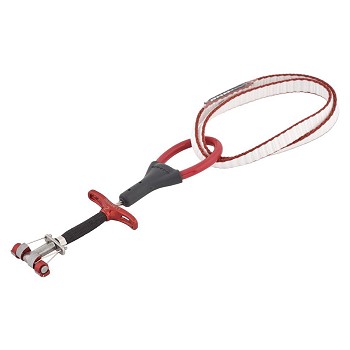

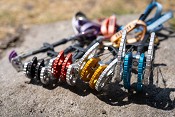
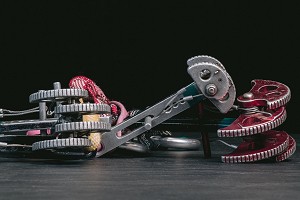

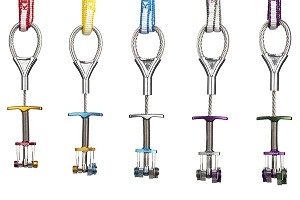
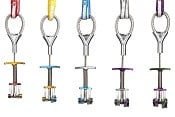
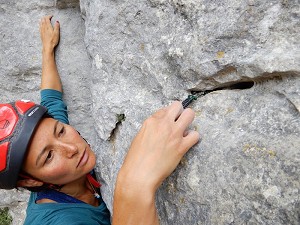

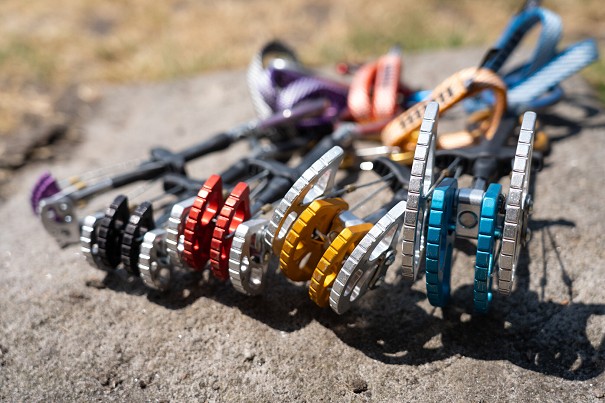

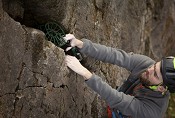

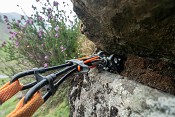
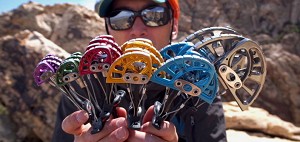

Comments
I took an absolute monster lob off Sacre Coeur (E2 5c) in August, ripping two RPs and a No. 1 brass straight through the culm, falling about 13-14 meters in total. That next piece, the one that held? The yellow dragonfly.
Splendid pieces of kit. Don't enter the E grades without 'em.
I like the way that Aliens/totem basics/maybe BD micros? Fit the same sizes where they overlap as it means you can take one type or the other... maybe a clever sales ploy from DMM?
They do look good though is a shame they’ve not gone for a softer alloy. A major plus is that they are in regular production though I guess!
on a final note, more effort next time during the testing process please Theo! If you aren’t whipping on to these things or at least putting your life on the line during testing then I think you should hand over kit to more committed testers ;)
Interesting answer to this one, and realistically the review will need to be updated accordingly, but we've been speaking to DMM about this over the course of the day and the response is potentially quite positive.
As a quick recap, the Totem Basics feature 6061 alloy, whereas the Dragonflys' feature 6082. On the surface of things that does indeed suggest they are harder, but here's what DMM had to say:
“6061 and 6082 are essentially the same alloy with the same hardness. 6082 has slightly better corrosion resistance. 6061 is commonly available in America as it conforms to ASTM (American standard) and 6082 is more commonly available in EU as it is made to EN standard."
As such, it would appear that they're fundamentally like-for-like in terms of softness.
Thanks to DMM for a) the clarification and b) keeping it soft :-)
I stand corrected :)
Cheapest place to buy them?!